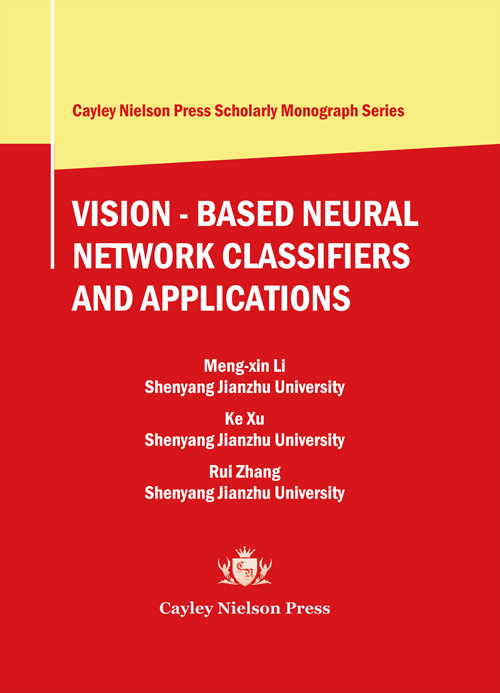
VISION - BASED NEURAL NETWORK CLASSIFIERS AND APPLICATIONS

Meng-Xin Li
Shenyang Jianzhu University
Ke Xu
Shenyang Jianzhu University
Rui Zhang
Shenyang Jianzhu University
Copyright © 2017 by Cayley Nielson Press, Inc.
ISBN: 978-0-692-86451-7
Cayley Nielson Press Scholarly Monograph Series Book Code No.: 129-11-4
US$114.50
Preface
Pattern recognition is widely applied in various fields such as optical character recognition (OCR), fingerprint and facial recognition, part classification in industrial applications, and blood and electocardiogram analysis in medical applications. Visual defect inspection is an important part of quality assurance in many fields of production. As a typical example, wood veneer inspection plays an important role in a real life application of industry.........
Contents
Preface........................................................................................................................................... I
Chapter 1 Introduction...................................................................................................... 1
1.1 Background....................................................................................................................... 1
1.1.1 Automatic Visual Inspection............................................................................... 2
1.1.2 Neural Networks for Pattern Recognition................................................ 3
1.1.3 Rough Set Theory..................................................................................................... 4
1.2 Object of This Research............................................................................................. 5
1.3 Organization of the Monograph........................................................................... 6
Chapter 2 Literature Review.......................................................................................... 9
2 Previous Research on Wood Veneer Inspection.......................................... 9
2.1 Feature Selection Problem................................................................................... 11
2.1.1 Overview of Rough Set Theory..................................................................... 12
2.1.1.1 Data representation in rough sets.......................................................... 12
2.1.1.2 Data Analysis in Rough sets......................................................................... 13
2.1.1.3 Decision Rules in Rough Sets...................................................................... 14
2.1.1.4 Attribution discretization.............................................................................. 15
2.1.2 Rough Sets for Feature Selection and Classification........................ 16
2.1.2.1 Application of rough sets algorithm in feature selection......... 17
2.1.2.2 Application of rough sets in pattern classification........................ 17
2.2 Neural Networks for Classification................................................................. 20
2.2.1 Topology of Neural Networks........................................................................ 23
2.2.1.1 Backpropagation Network........................................................................... 23
2.2.1.2 Radial Basis Function Neural Network................................................ 26
2.2.1.3 Modular neural network............................................................................... 26
2.2.2 Training Strategies of Neural Networks.................................................. 28
2.3 Optimisation Design of Neural Networks................................................... 33
2.3.1 Methods for Optimising Neural Networks............................................. 33
2.3.2 Uniform Design Method..................................................................................... 38
Chapter 3 An improved BP neural network classifier................................ 41
3.1 Introduction................................................................................................................... 41
3.2 MLP with a BP algorithm....................................................................................... 42
3.2.1 Forward Pass............................................................................................................ 42
3.2.2 Backward pass using the gradient descending method................ 43
3.3 Design of the MLP Classifier................................................................................ 44
3.3.1 Determination of the number of Hidden Layers............................... 44
3.3.2 Determination of the Number of Hidden Layer Neurons............ 45
3.3.3 Selection of the Initial Weights....................................................................... 46
3.4 Improved BP Neural Network........................................................................... 46
3.4.1.2 Self-adaptive Learning Rate......................................................................... 47
3.4.1.3 Dynamic Error Segmenting.......................................................................... 48
3.4.2 Structure of the Improved BP Neural Network.................................. 49
3.5 Features Extraction for Identifying Wood Defects............................... 50
3.6 Normalisation of Feature Values...................................................................... 51
3.7 Encoding of the Classifier Output..................................................................... 52
3.8 Experimental Results and Analyses................................................................ 53
Chapter 4 Rough sets based pattern recognition.......................................... 58
4.1 Introduction................................................................................................................... 58
4.2 Basic Concepts.............................................................................................................. 58
4.3 Attribute Discritization............................................................................................ 61
4.3.1 K-means Clustering Method............................................................................ 61
4.3.2 Fuzzy C-Clustering Method.............................................................................. 62
4.3.3 Hierarchical clustering method..................................................................... 63
4.3.4 Implementation of discretization using hierarchical clustering method 66
4.3.5 Comparison of the three clustering methods...................................... 73
4.4 Reduction of Attributes.......................................................................................... 74
4.5 Reduction of Attribute Values............................................................................ 77
4.6Acquisition of Decision Rules............................................................................... 80
Chapter 5 Rough sets based neural network pattern recognition..... 82
5.1 Introduction................................................................................................................... 82
5.2 Variable Precision Rough Sets........................................................................... 82
5.3 Reduction of condition attributes with VPRS........................................... 86
5.4 Generation of Probaalilistic Decision Rules.............................................. 87
5.5 VPRS for featrue classification of wood veneer defects................... 88
5.6 Rough Sets Based Neural Network Classifier.......................................... 92
5.7 Experiments................................................................................................................... 93
Chapter 6 A classifier using rough sets based neural network with fuzzy input (RNNFI) 96
6.1 Introduction................................................................................................................... 96
6.2 Why Fuzzy Data Processing................................................................................ 97
6.2.1 Fuzzifier........................................................................................................................ 98
6.2.2 Fuzzy rule base........................................................................................................ 98
6.2.3 Fuzzy inference engine....................................................................................... 99
6.2.4 Defuzzifier................................................................................................................ 100
6.3 Fuzzy sets and rough sets.................................................................................. 100
6.4 A Neural Network with Fuzzy Input for Wood Veneer Inspection 101
6.5 A Classifier Using Rough Sets Based Neural Network with Fuzzy Input 102
6.6 Experiments................................................................................................................ 104
Chapter 7 Optimisation for the RNNFI classifier......................................... 113
7.1 introduction................................................................................................................ 113
7.2 Uniform design.......................................................................................................... 113
7.3 Uniform design for the RNNFI CLASSIFIER........................................... 114
7.3.1 UD table..................................................................................................................... 114
7.3.2 Response surface modelling........................................................................ 117
7.3.3 Modelling the RNNFI performance.......................................................... 119
7.3.4 Finding optimal factor settings with NLPQL...................................... 120
7.4 Comparative evaluation of classification methods for wood veneer defects 125
Chapter 8 Integration of the RNNFI system................................................... 127
8.1 Introduction................................................................................................................ 127
8.2 Activex technology.................................................................................................. 127
8.3 system integration using activex and vb.................................................. 128
References............................................................................................................................ 136
Readership
This book should be useful for students, scientists, engineers and professionals working in the areas of optoelectronic packaging, photonic devices, semiconductor technology, materials science, polymer science, electrical and electronics engineering. This book could be used for one semester course on adhesives for photonics packaging designed for both undergraduate and graduate engineering students.
